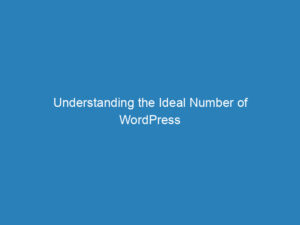
Understanding the Risks and Benefits of Using Multiple WordPress Plugins
Understanding the Implications of Overloading WordPress Plugins
With the flexibility offered by WordPress, the sky is the limit when it comes to customization. From running an ecommerce store to starting a membership-based community, the platform offers thousands of plugins that enable you to tailor your site to your specific needs. However, with great power comes great responsibility, especially when it comes to managing these plugins.
The Risks of Too Many WordPress Plugins
Despite the versatility they offer, incorporating too many plugins into your website can lead to security vulnerabilities, website maintenance headaches, potential conflicts and compromised performance. Here’s why:
1. Security Risks
Even the most experienced developer can make mistakes. This means that the more plugins you install, the higher the risk of inadvertently integrating one with a security vulnerability. Always update your plugins regularly to ensure that any bugs or vulnerabilities are fixed, reducing the risk of hackers accessing your site.
2. Learning Curves
Each plugin on the WordPress repository is created by different developers, with diverse solutions. This means that not all plugins function similarly, have identical settings or offer the same level of customization. The time required to understand each plugin can add up, and there’s often maintenance involved to ensure that each one functions properly.
3. Plugin Conflicts
WordPress is an open-source platform, which means any developer can submit a plugin to the repository. This diversity can lead to conflicts between two or more plugins, causing slow-loading pages, error messages or broken functionality. A plugin conflict can even cause a website to crash.
4. Poor Site Speed
Too many plugins can affect your page load time and the overall performance of your site. Each activated plugin sends a server request from the user’s browser to your website’s server and back. The more plugins in use, the more requests being made, which can slow down your site. Moreover, plugins use database queries to retrieve and store information, so more plugins mean more queries, increasing the load on your database server and slowing down your site even more.
How Many Plugins is Too Many?
The answer to this question is not definitive, as it depends on the quality of the plugins you use, the load they put on your site, and your hosting provider. The key is to use only the necessary plugins needed to achieve the functionality and design that you desire. It’s also crucial to consider the quality of the plugins you use, researching their source, reviews, active users, support and documentation.
What’s the Best Approach?
Consider the functionality that’s important to your site and only install plugins that meet those needs. If a plugin is no longer in use, you should deactivate and uninstall it. Additionally, choosing plugins that serve more than one purpose can be beneficial.
For example, Jetpack is a multipurpose plugin that offers a range of functionalities, from security and speed solutions to design tools and marketing features. It comes with the advantage of learning one dashboard and one interface, simplifying your workload and workflow.
Getting Started with Jetpack
While Jetpack offers an extensive range of features, getting started is relatively straightforward:
- Log into your WordPress dashboard.
- Click Plugins on the left-hand menu.
- Click Add New at the top.
- Search for “Jetpack” if it’s not already featured.
- Click Install Now → Activate.
- On the Setup screen, click Set Up Jetpack.
- Create a WordPress.com account or log into an existing one.
- Choose which features to activate on your site.
In conclusion, understanding your website’s priorities and doing some research before installing plugins should be your first step. Only use the necessary plugins to maintain a fast, secure and efficient website.

